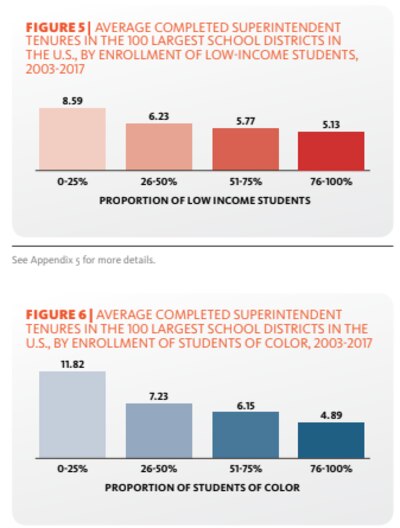The statistic comes up nearly every time a big name in education steps down: the average big-city school superintendent only lasts three years in the job.
The factoid reinforces a common view of urban school districts as dysfunctional places with ever-rotating leadership. The problem, according to a report released Tuesday by the Broad Center, is that the three-year figure isn’t accurate — and it’s not clear it ever has been.
In fact, recent leaders of the 100 largest school districts in the country have lasted an average of just over six years; for big-city districts, it was five and a half years.
“While some districts struggle to retain the leaders they hire — and that should not be discounted — many discussions about the average tenure of superintendents appear to be rooted in a fundamental misinterpretation of results from past superintendent surveys,” the report says.
The analysis tracks the leadership of the country’s 100 largest school districts based on a survey, media reports, and district announcements. It focuses on the 242 superintendents who completed their tenure between 2003 and 2017.
Why is the number so far off from conventional wisdom? The three-year figure comes from a survey by the Council of the Great City Schools, most recently conducted in 2014, about how long current superintendents have been in their roles. Since those leaders were still serving, their tenures may last much longer. But that number is often reported as the average length of a superintendent’s tenure, start to finish. (A more precise figure from that same survey, looking at completed tenures, has been more often ignored.)
The three-year number has been mentioned, often without caveat, in outlets including the New York Times, Washington Post, Education Week, and, yes, Chalkbeat.
“The three-and-a-half year number has stuck around, I think, because it fits a narrative that people like and there isn’t any counterfactual,” said Josh Starr, a former superintendent in Connecticut and Maryland and the CEO of PDK International. Still, he said, the new information is just one more data point in a confusing landscape, since it’s not always clear how to distinguish between urban and suburban districts and because especially long-serving leaders can skew averages.
The new Broad Center report includes all 100 largest U.S. school districts; the Great City Schools survey included 53 of its 65 district members.
The Broad Center report also runs the tenure numbers for those 53 specific districts. It finds the average full-length tenure for a leader there was five and a half years.
Turnover hits some districts harder than others
That’s not to say to turnover among district leaders isn’t a problem. The latest report finds that nearly a quarter of superintendents leave before serving for three years, and the majority leave before serving for six.

Then there’s the fact that certain districts — namely those with more low-income students and more students of color — see much more churn than others. As far as stable leadership goes, students who may already lag behind are more often in districts that lack it.
There’s not much research on whether longer superintendent tenures are linked to higher student achievement; one recent study focusing on Florida and North Carolina found only inconsistent evidence.
The Broad Center report also documents stark gender disparities. Over the time period of the study, just about one in five superintendents in the largest 100 districts were women. Among those who were hired, they stayed in their jobs for shorter periods — 5.2 versus 6.4 years.
Perhaps most surprising is the candid admission in the report that superintendents associated with the Broad Center — which runs a controversial training program for aspiring school system leaders, funded by Los Angeles philanthropist Eli Broad — have substantially shorter tenures than other district leaders. Broad-trained leaders last for an average of just 3.5 years.
The sample size here is fairly small, as 29 Broad-trained leaders have completed superintendencies. Among the 12 current Broad-trained district heads, the average tenure is 3.4 years; the average length of a current superintendent’s tenure nationwide is 3.8 years.
“Regardless of where our network members work, they should act with urgency on behalf of the students, families and communities they serve, and we are deeply concerned when they don’t make lasting improvements,” the report says.


